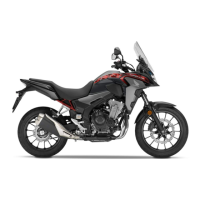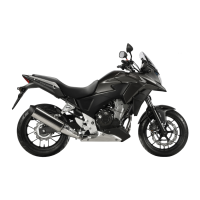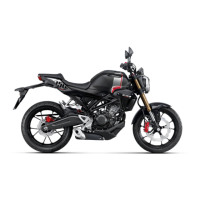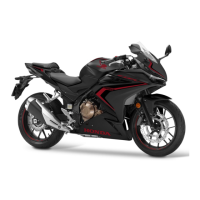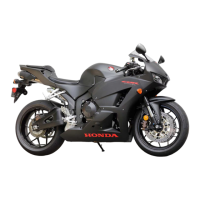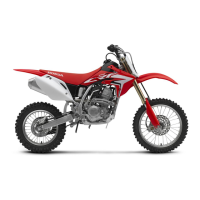Do you have a question about the Honda CB500X 2020 and is the answer not in the manual?
Follow safety guidelines for routine inspections, fuel tank safety, and proper riding practices.
Labels on the vehicle provide hazard warnings. Read carefully and do not remove them.
Emphasizes cautious riding, passenger safety, and wearing approved protective apparel.
Covers break-in period, brake use, low traction caution, and engine braking techniques.
Advises against non-approved accessories/modifications to ensure safety and warranty.
Discusses how weight affects handling and provides guidelines for proper loading.
Diagrams and labels identifying key vehicle parts for easy reference.
Explains the instrument panel, its displays, indicators, and operating buttons.
Guides on setting time format, clock, backlight brightness, and units.
Covers settings for REV indicator, RPM, and tachometer display modes.
Explains the function of various dashboard indicators like turn signals and warning lights.
Details the operation of ignition, engine stop, hazard, horn, and turn signal switches.
Step-by-step procedure for starting the engine and troubleshooting common issues.
Explains the 6-speed transmission and recommended shift points for optimal performance.
Instructions for opening/closing fuel cap, fuel type, and octane recommendations.
Information on helmet holder, tool kit, and document bag locations.
Stresses regular maintenance for vehicle safety, performance, and longevity.
Outlines recommended maintenance tasks and their required frequencies.
A logbook for tracking performed maintenance, dates, and service details.
Covers essential pre-ride checks, periodic inspections, and part replacement.
Procedures for battery removal, installation, cleaning, and charging.
Instructions for removing and reinstalling the vehicle seat.
Procedures for removing and installing the left side body panel.
Guide to checking engine oil level and adding oil as needed.
Instructions for replacing the air cleaner element to maintain engine performance.
How to check coolant level and add coolant to the reserve tank.
Covers checking brake fluid levels and inspecting brake pad wear.
Steps to adjust the brake light switch for proper activation timing.
How to check side stand operation and spring condition.
Procedures for inspecting drive chain slack and wear.
Detailed steps for adjusting drive chain slack and rear axle alignment.
Guide to checking clutch lever freeplay and the condition of the clutch cable.
Instructions for adjusting clutch lever freeplay using upper and lower adjusters.
How to check throttle rotation, freeplay, and cable condition.
Procedure for adjusting the vertical aim of the headlight.
How to adjust the brake lever distance to the handlebar grip.
Guide to adjusting front fork spring preload for different loads.
How to adjust rear shock absorber spring preload using a pin spanner.
Instructions for changing the windscreen height between two positions.
Steps to diagnose and resolve issues when the engine won't start.
Identifies overheating symptoms and the procedure to follow.
Actions to take if the low oil pressure warning light illuminates.
What to do if the PGM-FI indicator lights up during riding.
Explains ABS indicator behavior and its implications for braking.
Describes how fuel system errors are indicated on the fuel gauge.
Explains how cooling system errors are displayed on the gauge.
Guidance on emergency tire repair and wheel removal for punctures.
Troubleshooting steps for common electrical issues like dead battery.
Procedure for replacing burned-out headlight, taillight, and signal bulbs.
How to locate, inspect, and replace blown fuses in the fuse box and main fuse.
Information on ignition keys, key tags, and obtaining duplicate keys.
Overview of ignition switch, engine stop switch, odometer, and tripmeter.
Guidelines for washing, polishing, and protecting the vehicle's finish.
Advice on long-term storage, including battery care and vehicle preparation.
Proper methods for safely transporting the motorcycle on trailers or trucks.
Tips for environmentally conscious vehicle cleaning and waste disposal.
Location and significance of the VIN and engine serial number.
Explains exhaust, noise, and evaporative emission requirements and systems.
Details the function and care of the catalytic converter.
Information on approved fuel blends containing alcohol or ether compounds.
Lists available service and owner's manuals for reference.
Outlines vehicle warranties and the process for service and repairs.
Contact details for customer relations and inquiries.
Key physical dimensions, weights, capacities, and gear ratios of the vehicle.
Technical specifications for tires, fluids, spark plugs, and engine oil.
Lists the types and specifications for all vehicle bulbs.
Details the amperage ratings for all vehicle fuses.
Crucial torque values for tightening various bolts and fasteners.
Follow safety guidelines for routine inspections, fuel tank safety, and proper riding practices.
Labels on the vehicle provide hazard warnings. Read carefully and do not remove them.
Emphasizes cautious riding, passenger safety, and wearing approved protective apparel.
Covers break-in period, brake use, low traction caution, and engine braking techniques.
Advises against non-approved accessories/modifications to ensure safety and warranty.
Discusses how weight affects handling and provides guidelines for proper loading.
Diagrams and labels identifying key vehicle parts for easy reference.
Explains the instrument panel, its displays, indicators, and operating buttons.
Guides on setting time format, clock, backlight brightness, and units.
Covers settings for REV indicator, RPM, and tachometer display modes.
Explains the function of various dashboard indicators like turn signals and warning lights.
Details the operation of ignition, engine stop, hazard, horn, and turn signal switches.
Step-by-step procedure for starting the engine and troubleshooting common issues.
Explains the 6-speed transmission and recommended shift points for optimal performance.
Instructions for opening/closing fuel cap, fuel type, and octane recommendations.
Information on helmet holder, tool kit, and document bag locations.
Stresses regular maintenance for vehicle safety, performance, and longevity.
Outlines recommended maintenance tasks and their required frequencies.
A logbook for tracking performed maintenance, dates, and service details.
Covers essential pre-ride checks, periodic inspections, and part replacement.
Procedures for battery removal, installation, cleaning, and charging.
Instructions for removing and reinstalling the vehicle seat.
Procedures for removing and installing the left side body panel.
Guide to checking engine oil level and adding oil as needed.
Instructions for replacing the air cleaner element to maintain engine performance.
How to check coolant level and add coolant to the reserve tank.
Covers checking brake fluid levels and inspecting brake pad wear.
Steps to adjust the brake light switch for proper activation timing.
How to check side stand operation and spring condition.
Procedures for inspecting drive chain slack and wear.
Detailed steps for adjusting drive chain slack and rear axle alignment.
Guide to checking clutch lever freeplay and the condition of the clutch cable.
Instructions for adjusting clutch lever freeplay using upper and lower adjusters.
How to check throttle rotation, freeplay, and cable condition.
Procedure for adjusting the vertical aim of the headlight.
How to adjust the brake lever distance to the handlebar grip.
Guide to adjusting front fork spring preload for different loads.
How to adjust rear shock absorber spring preload using a pin spanner.
Instructions for changing the windscreen height between two positions.
Steps to diagnose and resolve issues when the engine won't start.
Identifies overheating symptoms and the procedure to follow.
Actions to take if the low oil pressure warning light illuminates.
What to do if the PGM-FI indicator lights up during riding.
Explains ABS indicator behavior and its implications for braking.
Describes how fuel system errors are indicated on the fuel gauge.
Explains how cooling system errors are displayed on the gauge.
Guidance on emergency tire repair and wheel removal for punctures.
Troubleshooting steps for common electrical issues like dead battery.
Procedure for replacing burned-out headlight, taillight, and signal bulbs.
How to locate, inspect, and replace blown fuses in the fuse box and main fuse.
Information on ignition keys, key tags, and obtaining duplicate keys.
Overview of ignition switch, engine stop switch, odometer, and tripmeter.
Guidelines for washing, polishing, and protecting the vehicle's finish.
Advice on long-term storage, including battery care and vehicle preparation.
Proper methods for safely transporting the motorcycle on trailers or trucks.
Tips for environmentally conscious vehicle cleaning and waste disposal.
Location and significance of the VIN and engine serial number.
Explains exhaust, noise, and evaporative emission requirements and systems.
Details the function and care of the catalytic converter.
Information on approved fuel blends containing alcohol or ether compounds.
Lists available service and owner's manuals for reference.
Outlines vehicle warranties and the process for service and repairs.
Contact details for customer relations and inquiries.
Key physical dimensions, weights, capacities, and gear ratios of the vehicle.
Technical specifications for tires, fluids, spark plugs, and engine oil.
Lists the types and specifications for all vehicle bulbs.
Details the amperage ratings for all vehicle fuses.
Crucial torque values for tightening various bolts and fasteners.
| Bore x Stroke | 67mm x 66.8mm |
|---|---|
| Compression Ratio | 10.7:1 |
| Ignition | Computer-controlled digital transistorized with electronic advance |
| Transmission | 6-speed |
| Final Drive | Chain |
| Rear Brake | Single 240mm disc |
| Front Tire | 110/80-19 |
| Rear Tire | 160/60-17 |
| Rake (Caster Angle) | 27.5° |
| Starter | Electric |
| Engine Type | Liquid-cooled parallel-twin |
| Induction | PGM-FI fuel injection |
| Front Suspension | 41mm telescopic fork |
| Rear Suspension | Pro-Link single shock |
| Front Brake | Single 310mm disc |
| Trail | 4.3 inches |
| Seat Height | 830mm (32.7 inches) |
| Fuel Capacity | 4.6 gallons |
| Max Power Output | 47 hp @ 8, 600 rpm |
| Width | 825mm (32.5 inches) |
| Fuel Capacity (liters) | 17.5 liters |
| Max Torque | 31.7 lb-ft @ 6, 500 rpm |
| Wheelbase (mm) | 1445 |
